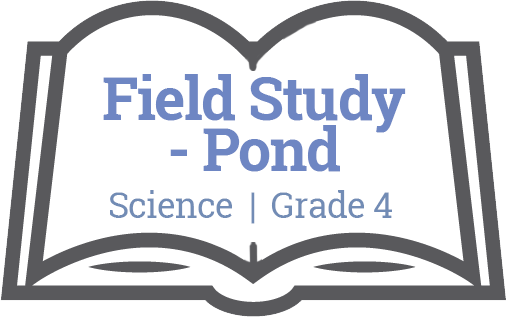
Unit Plan: Field Study – Pond
Science / Grade 4

Big Ideas
Science
- All living things sense and respond to their environment.
Concepts:
- Interactions
- Environment
- Survival
- Stewardship
- Interdependence
- Ecosystems
- Adaptation
Essential Questions
Students will keep considering…
- How do living things sense and respond to their environment?
- What does using my senses in nature look, sound, feel, taste and smell like?
- How do my senses compare to the senses of other plants and animals?
- How is sensing and responding related to interdependence within ecosystems?
Evaluative Criteria
N/A
Monitoring Progress
Teacher will monitor progress:
Teachers can monitor progress through ongoing formative assessment including but not limited to:
- Class discussion
- Group and pair discussions
Resources
AUDIO
TEXTS
- ODS Pond Orientation
- Beetles: Walk and Talk
- Beetles: I notice, I wonder, It reminds me of
- Pond ID Card
- Strange Beginnings by Karen Needham and Launi Lucas
- bioblitz Canada
VIDEO
Reflection
How will teachers and their students reflect on and evaluate the completed project?
Teacher Reflection
- What aspects of the field study went well?
- What did students struggle with?
- What did you struggle with?
- What would you add/revise the next time you taught this field study?
- What connections can I make back to my school learning community?
- Organize a bioblitz event in your school yard or in nearby nature.
- Develop a plan of action to address a selected environmental problem or issue related to water systems
Downloads
Stage 1 – Desired Results
Big Ideas
- All living things sense and respond to their environment.
Concepts:
- Interactions
- Environment
- Survival
- Stewardship
- Interdependence
- Ecosystems
- Adaptation
Transfer Goals
Students will be able to independently use their learning to…
- Use their sense to make observations in the environment
- Connect to place and understand their role and responsibility as stewards of the environment.
- Discover and compare their senses to a variety of organisms, both aquatic and terrestrial.
- Develop a plan of action to address a selected problem or issue in school or community.
Meaning
Students will understand that…
- Living things have senses that detect changes in their environment.
- Living things respond to changes in their environment.
- Anything that causes a living thing to react is called a stimulus.
- Response to a stimulus is important for its survival.
Students will keep considering…
- How do living things sense and respond to their environment?
- What does using my senses in nature look, sound, feel, taste and smell like?
- How do my senses compare to the senses of other plants and animals?
- How is sensing and responding related to interdependence within ecosystems?
Acquisition
Students will be skilled at…
- Demonstrate curiosity about the natural world
- Explore and pose questions that lead to investigations
- Safely use appropriate tools to make observations and measurements
- Make observations about living & non-living things in the local environment
- Collect simple data
- Experience & interpret the local environment
- Identify some simple environmental implications of their & others’ actions
- Contribute to care for self, others, & community through personal or collaborative approaches
- Express & reflect on personal, shared, others’ experience of place
CORE COMPETENCIES
Communication:
- Students will use scientific language to exchange ideas with peers.
Critical Thinking:
-
Students will ask & answer questions through observation.
Social Responsibility:
- Students will participate in citizen science by sharing data with other field study groups.

The following resources are made available through the British Columbia Ministry of Education. For more information, please visit BC’s New Curriculum.
Big Ideas
The Big Ideas consist of generalizations and principles and the key concepts important in an area of learning. The Big Ideas represent what students will understand at the completion of the curriculum for their grade. They are intended to endure beyond a single grade and contribute to future understanding.
Core Competencies
 Communications Competency
Communications Competency
The set of abilities that students use to impart and exchange information, experiences and ideas, to explore the world around them, and to understand and effectively engage in the use of digital media
 Thinking Competency
Thinking Competency
The knowledge, skills and processes we associate with intellectual development
 Social Competency
Social Competency
The set of abilities that relate to students’ identity in the world, both as individuals and as members of their community and society
Curricular Competencies & Content
Curricular Competencies are the skills, strategies, and processes that students develop over time. They reflect the “Do” in the Know-Do-Understand model of curriculum. The Curricular Competencies are built on the thinking, communicating, and personal and social competencies relevant to disciplines that make up an area of learning.
Additional Resources
First People's Principles of Learning
To read more about First People’s Principles of Learning, please click here.
For classroom resources, please visit the First Nations Education Steering Committee.
